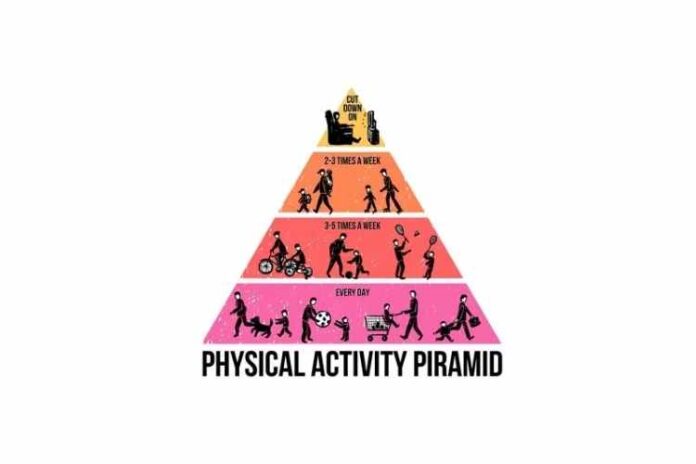In this blog we are going to tell you about physical activity pyramid, so read this blog carefully to get the complete information.
While we are all aware of the benefits of keeping our bodies active, our muscles strong, and our flexibility good, many of us struggle to incorporate these activities into our daily routines. Sometimes our avoidance is brought on by a lack of energy, but it can also be a result of our fear of suffering an injury, aches and pains, arthritis, or even chronic discomfort. To maintain physical activity in our daily routine, the Physical Activity Pyramid is the best model for you.
In this article, we will discuss the 5 levels of the Physical Activity Pyramid.
About Physical Activity Pyramid
The Physical Activity Pyramid is a plan that assists adults in making physical activity a simple, regular part of their daily lives. The physical activity pyramid is similar to the food pyramid in that the greatest and most significant activities for healthy daily life are found at the bottom, while the least healthy activities—or those you should undertake in moderation—are found at the top. The Physical Activity Pyramid aims to steadily enhance your physical activity levels while lowering your inactivity levels.
Following the pyramid’s suggested exercises has allowed people to become more active and establish a healthy habit that can assist build endurance while also maintaining and even improving their cardiac and musculoskeletal health.
Health benefits of the Physical Activity Pyramid
Regular exercise is incredibly beneficial to your body. Your tissues receive oxygen and nutrients via exercise, which can also strengthen and improve the efficiency of your cardiovascular system. Going for a 30-minute stroll a few times a week will significantly reduce your risk of developing health problems.
RELATED – Best paying jobs in capital goods – Know in detail
Level – 1 Moderate Physical activity
The Physical Activity Pyramid’s first stage, moderate physical activity, should be engaged in everyday or nearly daily. Exercise that is comparable to brisk walking is considered moderate activity. It covers some routine everyday tasks (also known as lifestyle activities), such as housework and yardwork (like raking leaves or mowing the lawn) (for example, mopping the floor). It also includes less physically demanding games like bowling and golf. Other sports can be either energetic or moderately intense; for instance, shooting basketballs is often a vigorous activity whereas playing a full-court game is moderate. Teenagers should engage in 60 minutes of moderate to intense movement each day, according to national guidelines.
Level- 2 Vigorous Aerobics
The Physical Activity’s Second Step Pyramid stands for vigorous aerobics, which covers any workout you can perform for an extended period of time without pausing and that is intense enough to raise your heart rate, cause you to breathe more quickly, and cause you to work up a sweat. So, compared to moderate exercises like brisk walking, these activities are more intense. Continuous vigorous activities, such jogging and aerobic dancing, are the norm. They have similar health and wellbeing advantages to moderate activity, and they’re particularly beneficial for enhancing cardiorespiratory endurance. In order to achieve national activity recommendations, you should engage in intense aerobics (or vigorous sport or recreation) at least three days a week for at least 20 minutes each day.
Level – 3 Vigorous sport and recreation
The Physical Activity Pyramid’s third step, strenuous sport and recreation, requires you to breathe more quickly and perspire more than usual, just like vigorous aerobics does. Your heart beats more quickly as your muscles consume more oxygen, and you breathe more quickly and deeply to keep up with the demand. However, in contrast to strenuous aerobics, robust sport and recreation sometimes entail brief bursts of action followed by brief rest intervals (as in basketball, football, soccer, and tennis). These exercises offer equivalent fitness, health, and wellbeing advantages as strenuous aerobics when performed for at least 20 minutes daily in bouts of at least 10 minutes each.
Level – 4 Muscle Fitness Exercise
Exercises for muscle fitness makeup Step 4 of the physical activity pyramid and improve your strength, muscular endurance, and power. Resistance training (with weights or machines) and lifting your own body weight are both examples of muscle-building workouts (as in rock climbing, calisthenics, and jumping). This kind of exercise improves general health and wellness as well as performance, physical appearance, back health, posture, and bone strength. These exercises should be done two or three days a week and can be utilized to fulfill the requirements of the national activity recommendations.
Level – 5 Flexibility Exercise
Exercises that improve flexibility are included in Step 5 of the physical activity pyramid. Exercises that increase flexibility enhance balance and postural stability, according to ACSM. Additionally, there is some evidence to suggest that flexibility exercises may lessen aches and pains, stop injuries, and lower the chance of back problems. Exercises that increase flexibility can help you perform better in sports like gymnastics and dancing.
RELATED – 5 Benefits Of Using A Swimming Pool Maintenance Service
Conclusion
The pyramid’s top displays a balance scale to represent the necessity to balance the energy you receive from meals with the energy you expend (activity). Energy balance is the state in which the number of calories you consume each day from diet and exercise is equal. This kind of energy balancing is crucial for preserving a healthy body composition.
We Hope this blog is sufficient enough to provide the information about physical activity pyramid. Thanks for reading this blog.







